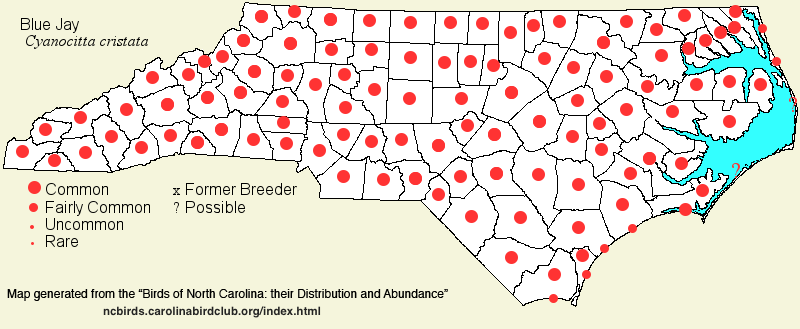 |  |
|
Blue Jay - Cyanocitta cristata CORVIDAE Members: | Search Common: Search Scientific: |
|
|
|||||||
| General Comments | The Blue Jay is one of our best known birds, breeding across the eastern half of the country, and certainly doing so in all 100 counties of the state. It also has noticeable spring and fall diurnal migrations, with small flocks moving just over treeline to the northeast in spring and southwest in fall. At all seasons, the species favors mature hardwood or mixed forests and woodlands, typically somewhat open, such as wooded residential areas; forests with a considerable number of oaks are preferred. Drier forests are also preferred over swamps. | ||||||
| Breeding Status | Breeder | ||||||
| NC BRC List | Definitive | ||||||
| State Status | |||||||
| U.S. Status | |||||||
| State Rank | S5B,S5N | ||||||
| Global Rank | G5 | ||||||
| Coastal Plain | Permanent resident, with some migratory movements. Common and conspicuous across the province; however, absent as a breeder, and usually in winter, on coastal islands. Uncommon on the Outer Banks in migration, but can be fairly common in migration along the southern coast. Peak counts: 500, Carolina Beach, 29 Sep 1962. | ||||||
| Piedmont | Permanent resident, with noticeable migratory movements. Common and conspicuous across the province, and often very common in spring and fall. Noticeable flights in Apr and early May, and late Sep to mid-Oct. Peak counts: 250, Catawba, 15 Apr 2002. | ||||||
| Mountains | Permanent resident, with very noticeable migratory movements. Common breeder to over 5,000 feet, but absent above about 5,500 feet. In winter, generally fairly common at lower and middle elevations; uncommon above perhaps 4,000 feet. Strong movements in late Apr and May, and in Sep - Oct, when it can be very common. Peak counts: | ||||||
| Finding Tips |
None needed. **** | ||||||
| Attribution | LeGrand[2023-03-26], LeGrand[2012-09-15], LeGrand[2011-12-10] | ||||||
| NC Map Map depicts all counties with a report (transient or resident) for the species. | Click on county for list of all known species. |
| NC Breeding Season Map Map depicts assumed breeding season abundance for the species. |  |